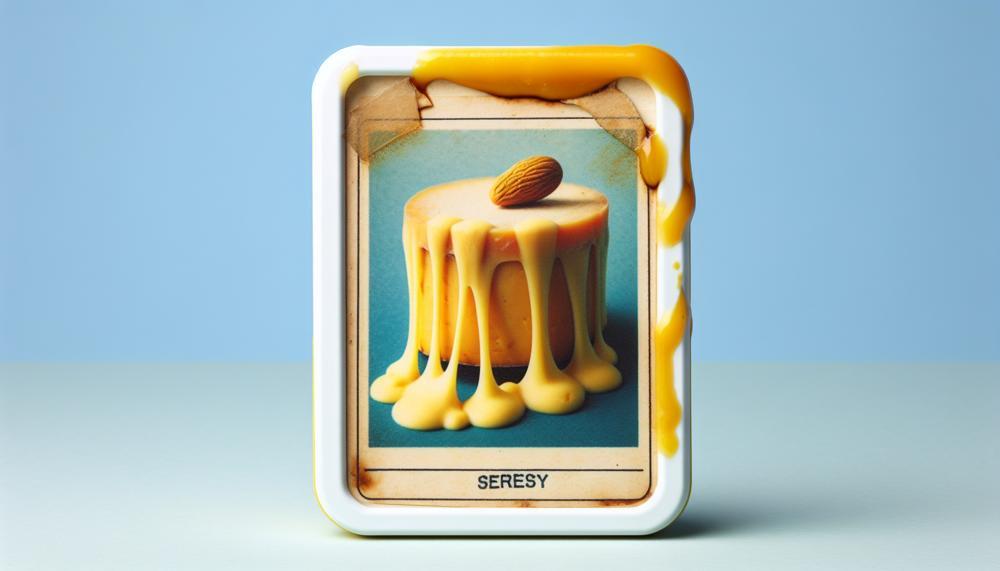Have you ever eagerly opened your fridge? Instead, you’re greeted by a block of cheese that looks and smells like it’s been left out in the sun for days? It’s a common occurrence, but one that can be avoided with a little knowledge.
In this blog post, we’ll dive into the world of spoiled cheese and how to identify it before it ruins your next meal.
Before we get started, let’s establish one thing. Always check the expiration date on your cheese. If it’s past its prime, there’s no point in risking it. But if you’re unsure or just want to double-check, here are some key things to look out for:
Firstly, take a good look at the color and texture of the cheese. Spoiled cheese may have a slimy or moldy appearance. Definitely not something you want to consume. And while we’re on the topic of appearances, give it a whiff as well. If the smell is off-putting or sour, chances are the cheese has gone bad.
But what about taste? Trust your taste buds – if the flavor is unpleasant or overly tangy, it’s time to bid farewell to that piece of cheese. And remember, proper storage is crucial in preventing spoilage. Keep your cheese wrapped tightly and refrigerated at all times to maintain freshness.
Don’t let spoiled cheese ruin your next meal. By learning how to identify and prevent it from happening in the first place, you can ensure that every bite of cheese is as delicious as it should be.
So, let’s start.
Contents
- 1 Knowing When Cheese is Rotten
- 2 Some Cheese Is Supposed to Smell
- 3 What Happens if We Eat Expired Cheese?
- 4 How Long Does Cheese Last in the Fridge?
- 5 What Does Bad Cheese Smell Like?
- 6 Is Cheese Still Good if There Is No Mold?
- 7 Can You Eat Cheese Past the Sell-By Date?
- 8 What Does Expired Cheese Look Like?
- 9 How to Keep Cheese Fresh for Longer?
- 10 Conclusion
Knowing When Cheese is Rotten
Yes, cheese can indeed go bad. It is vital to know when your cheese is spoiled and unfit for consumption. This can prevent food poisoning and potential health risks.
Here are some visual indications to look out for that show when cheese has gone bad:
| Indications | Causes |
| Unusual presence of mold | Bacterial growth due to improper storage or contamination |
| Color change | Bacterial breakdown of proteins or exposure to light and air |
| Slimy texture | Bacterial breakdown of proteins or moisture accumulation |
| Foul smell | Bacteria producing waste products or exposure to contaminants |
| Mold growth on cheese | Bacterial growth that can produce toxins and cause food poisoning |
| Unusual appearance or smell for the type of cheese | Indication of spoilage or contamination with harmful bacteria such as Listeria or E. coli |
If you happen to notice any of these signs, it is best to dispose of the cheese rather than risk falling ill. Different types of cheese have different characteristics when they spoil. For example, mozzarella turns yellow or becomes darker in color.
It is crucial to properly store and cook cheese at appropriate temperatures in order to prevent food poisoning.
Once opened, hard cheeses tend to have a longer shelf life than soft cheeses. However, all cheese should be stored in the fridge to avoid spoilage. Some signs that your cheese has gone bad include changes in color, texture, and smell.
If you suspect your cheese has gone bad, it is better to be safe and dispose of it properly.
Some Cheese Is Supposed to Smell
When it comes to cheese, some varieties are known for their strong smell. This is due to the bacteria cultures. They are added during the cheese-making process. The bacteria produce compounds that give cheese its characteristic aroma.
In addition, the aging process of cheese can also contribute to its pungent smell, as bacteria continue to grow and break down proteins and fats.
However, not all smelly cheeses are safe to eat. Soft or unwashed rind cheeses can develop mold or ammonia-like smells, which can be a sign of spoilage. These cheeses can also harbor harmful bacteria if not stored properly.
What Happens if We Eat Expired Cheese?
Eating expired cheese can cause foodborne illness and digestive problems. Harmful bacteria grow on expired cheese and produce toxins.
This can lead to unpleasant symptoms like diarrhea, queasiness, vomiting, stomach pain, headache, fever, chills, and muscle discomfort. It is crucial to store and handle cheese properly to avoid spoilage.
Eating expired cheese may leave you with more than just a bad taste in your mouth. In fact, it can lead to serious health consequences due to the growth of harmful bacteria and production of toxins. These harmful organisms thrive in the right conditions and can cause a range of gastrointestinal issues.
Symptoms of food poisoning from expired cheese can include: diarrhea, nausea, vomiting, abdominal cramps, headache, fever, chills, and muscle aches. This can be a major inconvenience and put a damper on your day.
So how does this happen? When cheese exceeds its expiration date, it becomes more susceptible to spoilage. The longer it sits in your fridge or on your counter, the greater the chances of harmful bacteria growing and multiplying. This is why proper storage is crucial to prevent spoilage.
Make sure to always check the expiration date on your cheese before consuming it. If it has passed the date, it’s best to toss it out rather than risk getting sick. And remember, proper storage is key – keep cheese in the fridge and away from sources of heat or sunlight.
How Long Does Cheese Last in the Fridge?
The lasting period of cheese can differ depending on various aspects like the kind of cheese, the environment it is stored in, and the existence of preservatives.
Typically, soft cheeses can endure for 1-2 weeks, while hard cheeses can remain edible for several months. The correct way of storing and handling is crucial in preserving the freshness of cheese for longer periods.
It’s always advisable to examine the label for any preservatives and consume the cheese within a week after opening it for the best quality.
What Does Bad Cheese Smell Like?
When it comes to determining if cheese has gone bad, there are several indicators to look out for. One of the most common ways to tell is by smelling it. Typically, bad cheese will have a strong and pungent odor that is distinctly different from its original smell.
However, it’s important to keep in mind that some types of cheese naturally have a strong smell. It’s always best to use your judgement and familiarize yourself with the normal scent of the cheese you are consuming.
Here are some specific steps you can take to determine if cheese has gone bad based on its smell:
- Check for aromas of ammonia and a rotting rind: These are universal signs of spoiled cheese and indicate that it should be thrown out immediately.
- Watch out for cleaner or urine-like smells: If the cheese has a distinct chemical smell, it’s a clear sign that it has gone bad and should not be consumed.
- Consider the type of mold present: If the cheese has visible mold, it doesn’t necessarily mean it is inedible. Some molds are safe to consume, while others can be harmful. However, if the mold is accompanied by a foul odor, it is best to err on the side of caution and discard the cheese.
- Understand the role of bacteria in cheese-making: The bacteria that make up the starter culture in cheese play a crucial role in determining its taste, texture, and smell. As cheese ages, these bacteria can intensify its aroma.
- Take note of any discoloration or visible mold: Cheese that looks moldy or discolored may not necessarily be spoiled. However, if it also has an unpleasant smell, it is likely time to throw it away.
Is Cheese Still Good if There Is No Mold?
Absolutely. Cheese can still be perfectly safe to consume even without any visible mold.

Nonetheless, it is crucial to thoroughly examine the cheese for any indications of spoilage, including alterations in smell, flavor, or consistency.
Some molds are harmless and can be removed by cutting them off. Others can be dangerous and cause foodborne illness.
It is always better to be safe than sorry. If you have any reservations about the cheese’s safety, it’s best to discard it.
Can You Eat Cheese Past the Sell-By Date?
While it may be tempting to do so, it’s important to carefully inspect the cheese for any signs of spoilage before consuming it. Even if there is no visible mold, a cheese that smells or looks off should be thrown out.
Proper storage also significantly affects cheese safety and shelf life.
The Difference Between Sell-By Date and Expiration Date
It’s essential to understand the distinction between a sell-by date and an expiration date. A sell-by date is merely an indication of the last date by which the manufacturer guarantees the quality of a product.
On the other hand, an expiration date indicates when a product is no longer safe for consumption. Therefore, a cheese that has passed its sell-by date may still be safe to eat. The safety depends on how it has been stored, and its overall appearance and smell.
Check for Signs of Spoilage
Before consuming cheese past its sell-by date, it’s crucial to carefully examine it for any signs of spoilage. If there are visible signs of mold or if the cheese has an off-smell or taste, it should be discarded immediately.
Soft cheeses like Brie or Camembert can also develop harmful bacteria if left out at room temperature for too long.
Proper Storage is Key
Proper storage is vital in determining the safety and shelf life of cheese. To prevent air exposure and reduce the growth of bacteria, cheese should always be stored in an airtight container or tightly wrapped in plastic wrap.
It should also be kept in the refrigerator at a consistent temperature. Keep it away from strong-smelling foods that could affect its flavor.
What Does Expired Cheese Look Like?
To visually determine if cheese has gone bad, there are a few key indicators to keep an eye out for. The first is the presence of mold. Some cheeses, like blue cheese, naturally have mold. However, if you start to see patches of different types of fuzz in varying colors or textures, that’s a clear sign that the cheese has spoiled. Do not eat it.
Another visual cue is a change in color. If your cheese starts to appear brown or yellow instead of its usual hue, it may be an indication that it has spoiled. Additionally, if you notice any slimy or discolored patches on the surface of your cheese, it is best to discard it.
Moreover, it is essential to use your best judgment based on how old your cheese is and how long it has been since you opened it. Soft cheeses like brie and feta have a shorter shelf life and should be consumed within a week of opening. On the other hand, harder cheeses like cheddar and parmesan can last for several weeks if stored properly.
Here is a chart outlining the recommended storage times for some common cheese varieties. It will help you understand how long to store each type.
| Type of Cheese | Recommended Refrigerator Storage Period |
| Fresh soft cheese (e.g. feta, mozzarella) | 1-2 weeks |
| Semi-soft cheese (e.g. brie, camembert) | 1 week |
| Hard cheese (e.g. cheddar, parmesan) | 3-4 weeks |
| Processed cheese slices or spreads | 2-3 weeks |
Remember, these are just general guidelines. It is crucial to always check for signs of spoilage before consuming any type of cheese. When in doubt, it is better to err on the side of caution and discard the cheese rather than risking food poisoning.
How to Keep Cheese Fresh for Longer?
If you want to keep your cheese fresh for a longer period of time, proper storage is key.
Follow these effective methods to ensure your cheese stays in optimal condition:
Choose the right storage location
It’s important to store cheese in a cool, dark place that is free from humidity and has enough space for it to breathe.
Avoid storing it near strong-smelling foods, as cheese can easily absorb odors.
Use the right wrapping
Different types of cheese require different storage methods. Soft and fresh cheeses should be wrapped in paper bags, cheese paper, or wax or parchment paper to allow for proper breathing.
For hard and aged cheeses, use plastic wrap or aluminum foil to prevent them from drying out.
Store in the fridge
Keep your cheese in the vegetable crisper drawer of your fridge. This will help maintain a consistent temperature.
Avoid placing it at the back of the fridge where temperatures can fluctuate.
Re-wrap after each use
To keep your cheese fresh, rewrap it in a fresh piece of plastic wrap or wax paper after each use. This helps prevent it from drying out when you put it back in the fridge.
Replace the wrapping and brine
To prevent bacteria growth and spoilage, make sure to replace the wrapping and brine (if applicable) every time you open the cheese.
Consume soft cheeses within a few days
Soft cheeses have a shorter shelf life compared to hard cheeses once opened.
For best results, consume them within a few days for optimal freshness.
Check for signs of spoilage
Keep an eye out for changes in color, texture, and odor as these are signs of spoilage in cheese. If you notice any changes, it’s best to discard the cheese rather than risk getting sick.
Follow these effective methods. Ensure your cheese stays fresh longer. This also reduces the risk of food poisoning from spoiled cheese.
Conclusion
In conclusion, being able to identify if cheese is bad is essential for both your health and taste buds.
Mold growth, changes in color and texture, and unpleasant odors are visual cues that show spoiled cheese. By paying attention to these signs, you can easily determine if your cheese has gone bad.
So, the next time you encounter a questionable block of cheese in your fridge, trust your senses. Use this guide to make an informed decision.




